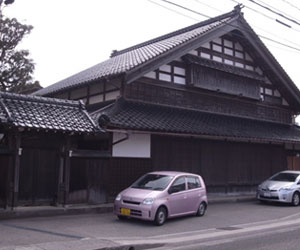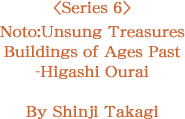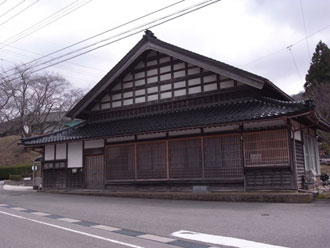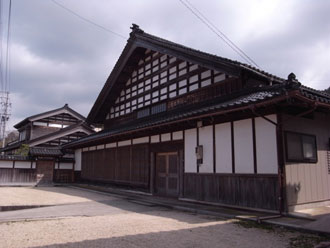

|
 |
At handmadejapan.com we have been introducing various skilled handmade crafts since 2000. We have sort to expose the essence of those crafts which are characterized and deeply rooted in the areas where the craftspeople live, are affect by local climate and history. And at the same time there has been a chance to enjoy the individual qualities of ceramics both rustic and fine, cloth, paper and items made of bamboo, too. In a series of ten articles under the heading of Noto: Unsung Treasures, the architect Shinji Takagi, who was born and raised in Wajima in Ishikawa prefecture, seeks to identify some of the interesting buildings and their background, old local customs and various pieces of engaging landscape, all of which might not make it into a tourist guide but are nevertheless of considerable interest. Driving north between Kanazawa and Wajima along the Noto Satoyama Highway, there are views of the Japan Sea off to the left and from Chiri-hama, we are treated to the beautiful sight of beaches and the breaking waves for some distance. After leaving the highway at the Tokuda Otsu exit and near the Yokota Toll Gate, the continuous wall of trees and bushes on the left is occasionally broken to afford us views of several gable ends of large buildings off in the distance. They are really striking pieces of architectural design, due for the most part to the contrasting black and white gable-end wall structure composed of dark struts and beams, and panels of white plaster. On a cold day last March,when there was till some snow on the ground, I made another trip, this time between Nanao and Hakui along one of Nanaoユs city streets though the area known as Higashi Ourai. It was round about lunch time, so I dropped into a noodle shop and got talking with the owner. It seems that in the past this area was really thriving and there were in fact two メhouses of ill reputeモ where the ladies of the night provided their services. Since those times, however, the amount of traffic passing through the area has decreased and now that there is a by-pass, this formerly colorful street is now really quiet. It seems, too, that there are a number of empty houses in the area. Before the coastal Noto Kaihin Toll Road was opened, the road from Kanazawa to Wajima actually passed through Nanao. In those days the road followed the railway, which carried most of the freight and passengers bound for Wajima. At the time, each of the communities along the line was characterized by the individuality of its station. Although main roads were surfaced, almost all of the roads outside of the big cities in Japan used to be stoney, unsurfaced tracks even in the late 1950s. I remember one summer, when I was a second year high-school student, it was so hot that the asphalt at the side of the road looked as though it would melt. Some friends and I decided that we would ride our pushbikes from Wajima to Kanazawa. After we left Nanao, we passed through Higashi Ourai on our way to Hakui. It was then that we rode between a number of these big buildings, some with their gable-ends facing the road, while others had their eaves toward the street. I can remember now how, even to me as a high-school student, these pieces of traditional architecture had a real presence and stature. On that blistering hot day, our throats dry from the dusty road, we were so glad of the shade these buildings afforded us as we passed through this sanctuary of shadow in the town. |
 
|
These really elegant buildings with stirring features and a stately air, came to be called azumadachi and were of course of a traditional style, with a large roof, gable-end walls with white plastered panels framed by struts and beams, and an additional lean-to to form an entrance in the gable-end facade facing the street. They were actually modeled on the samurai residences to be found in Kanazawa, a style that was to be used in the surrounding area for houses of those with status as well as for such buildings as temple or monastery kitchens. It seems, however, that the style did not come into more general use until the end of the nineteenth century. A similar style of building can be seen in the neighboring prefecture of Toyama where such large buildings dot the Tonami plain. In Nanao there are now fewer than there were in the past but there are still a number of them to be found here and there along the street. Making my way back home on that day last March, I stopped at a junction in Kue at one of those rare places in Japan that is not littered with unsightly advertising hoardings and went into a simple, unassuming tofu shop. When I got back home to Wajima I enjoyed the delicate natural flavors of my purchases and reflected on the beautiful facades I had seen and shall never forget those buildings of ages past. |
Shinji Takagi---Architect Born in Wajima in 1942. Worked on many projects using local materials and true lacquer for shops, houses and a variety of interior design schemes. Principal work includes Yuyado Sakamoto in Suzu: the repair and renovation of the true lacquer craftsman's house, Nurishi no Ie in Wajima: Meiso no Yakata in Toga, Toyama prefecture: the store Kombuya Shirai in Nanao and Kanazawa: a store selling Japanese candles, Takazawa Shoten in Nanao. Member on the Wajima City Council for the Protection of Cultural Properties Committee. Director of the NPO, Ishikawa Reed Thatch Culture Study Group. Bill Tingey---Translator Chief Designer to David Hicks in London before moving to Japan in 1976 and gaining a Masters Degree in History of Architecture. Worked in Japan as a photographer, designer, writer and translator. Returned to UK to continue work in 2000. |
| (2015/1 Yuko Yokoyama) |
|
(C)Copyright 2004 Jomon-sha Inc, All rights reserved. |